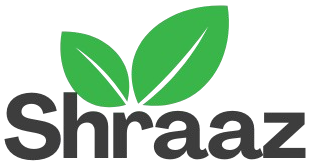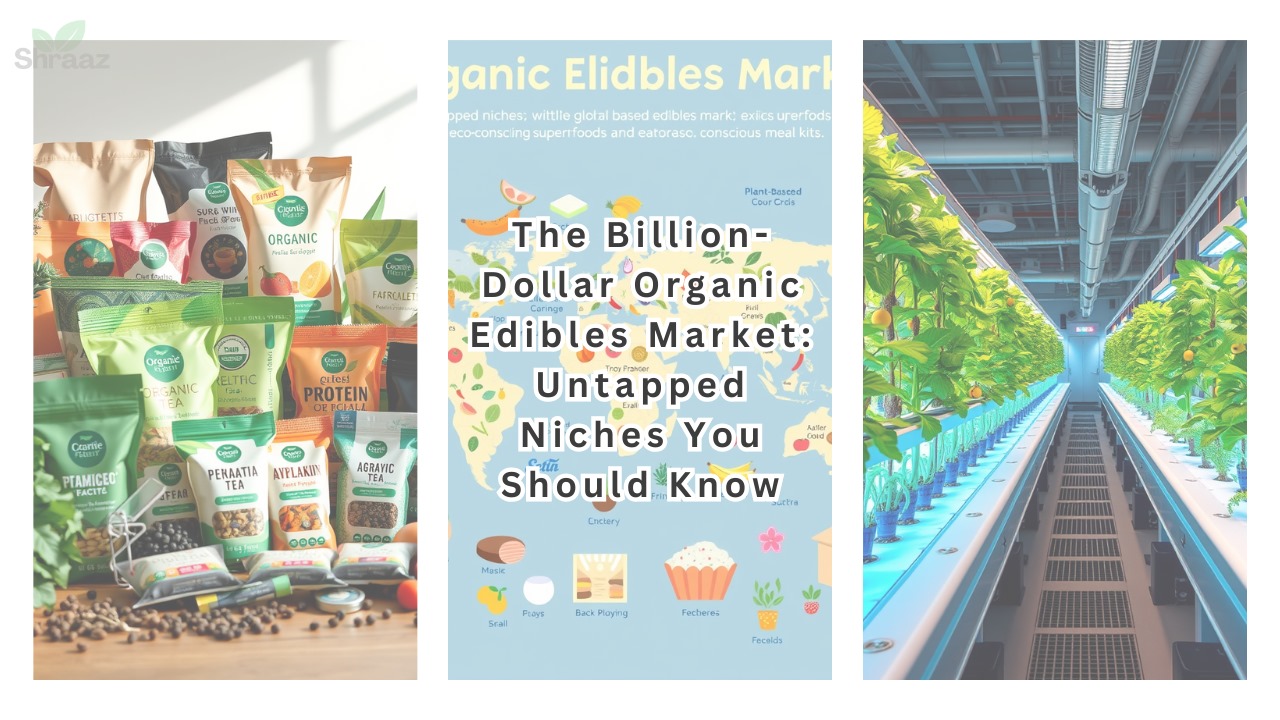Introduction: The Growing Landscape of Organic Edibles
The organic edibles market has experienced a significant boom in recent years, fueled by growing health consciousness, environmental concerns, and the demand for sustainable food choices. According to a report by Grand View Research, the global organic food and beverages market size was valued at over $200 billion in 2022 and is projected to reach $564 billion by 2030, growing at a compound annual growth rate (CAGR) of 13.6%.
Consumers are increasingly drawn to organic products due to their perceived health benefits, absence of synthetic chemicals, and alignment with eco-friendly practices. This growing demand presents a goldmine for marketers looking to explore niche segments within the organic edibles market.
We will uncover the untapped niches in the organic edibles industry, explore their potential, and offer actionable strategies for marketers to capitalize on these opportunities.
Understanding the Demand for Organic Edibles
The surge in demand for organic edibles can be attributed to several key factors:
1. Health Consciousness
Consumers are becoming more aware of the link between diet and health. A survey by the Organic Trade Association (OTA) revealed that 82% of U.S. households purchase organic products regularly, with health benefits being the primary motivator.
2. Environmental Concerns
Sustainability is a significant driver. Organic farming practices reduce the use of synthetic pesticides and fertilizers, promoting healthier ecosystems. Millennials and Gen Z consumers are especially focused on eco-conscious choices, making organic edibles a preferred option.
3. Regulatory and Labeling Standards
Governments worldwide are promoting organic farming through subsidies and certifications. Strict labeling laws, such as the USDA Organic certification, build consumer trust and encourage organic purchases.
| Key Drivers | Impact on Demand |
| Health Consciousness | Increased demand for clean, chemical-free foods |
| Environmental Concerns | Shift toward eco-friendly, sustainable products |
| Regulatory Support | Enhanced trust and adoption of organic certifications |
4. Convenience Meets Organic
Modern consumers are seeking convenience without compromising health. This demand has fueled growth in ready-to-eat organic snacks, beverages, and meal kits.
By understanding these factors, marketers can better tailor their strategies to target specific consumer pain points and motivations.
Identifying Untapped Niches in the Organic Edibles Market
The organic edibles market is vast, but several niche segments remain underexplored.
1. Organic Snacks
- Overview: The demand for healthy, grab-and-go options is skyrocketing. Organic energy bars, trail mixes, and baked goods cater to busy lifestyles.
- Target Audience: Health-conscious professionals, students, and parents.
- Market Insight: The global organic snack market is expected to grow at a CAGR of 11.8% through 2028, according to Market Research Future.
2. Herbal Teas and Functional Beverages
- Overview: Consumers are drawn to wellness drinks like herbal teas, kombucha, and functional beverages promoting relaxation, immunity, or digestion.
- Target Audience: Wellness enthusiasts, and fitness-focused individuals.
- Example: Brands like Pukka Herbs leverage organic ingredients and sustainability narratives.
3. Organic Meal Kits
- Overview: The rise in home cooking and convenience has spurred demand for organic meal kits tailored to dietary preferences (e.g., keto, vegan).
- Target Audience: Urban millennials, dual-income households.
- Example: Companies like Green Chef offer organic meal kits with pre-portioned ingredients.
| Niche | Key Features | Target Audience |
| Organic Snacks | Convenient, healthy, portable | Busy professionals, students |
| Herbal Teas & Beverages | Wellness-focused, eco-friendly | Fitness enthusiasts, wellness buffs |
| Organic Meal Kits | Tailored diets, easy preparation | Urban millennials, families |
4. Organic Baby and Kids’ Foods
- Overview: Parents are increasingly seeking clean, chemical-free options for their children, including baby food, snacks, and drinks.
- Market Growth: The global organic baby food market is projected to surpass $12 billion by 2030.
5. Niche Organic Condiments and Spices
- Overview: Gourmet cooking trends have spurred interest in organic spices and condiments. Exotic, high-quality options appeal to foodies and chefs.
- Example: Organic harissa and turmeric blends for health and taste.
Why Marketers Should Focus on Untapped Niches
The organic edibles market offers an array of untapped niches with significant growth potential. Here’s why these niches are especially attractive to marketers:
1. High Demand with Low Competition
- Emerging niches often have fewer players, reducing market saturation.
- First-mover advantage allows marketers to build brand recognition and customer loyalty before competitors enter.
2. Targeted Marketing Opportunities
- Niche markets enable precise targeting of specific consumer groups.
- Personalization leads to higher engagement and conversion rates.
3. Increased Willingness to Pay
- Consumers are often willing to pay a premium for niche organic products that align with their values (e.g., sustainability, health).
- For example, organic baby food buyers prioritize safety over cost, creating opportunities for value-based marketing.
4. Alignment with Emerging Consumer Trends
- Niches like functional beverages and meal kits tap into trends such as convenience, wellness, and sustainability.
- By aligning campaigns with these trends, marketers can generate organic traction.
5. Potential for Story-Driven Marketing
- Unique niches provide rich storytelling opportunities, such as the journey of sourcing ethical ingredients or supporting small farmers.
- These narratives resonate deeply with socially conscious consumers.
By focusing on these advantages, marketers can position themselves as leaders in niche organic markets and drive significant returns on investment.
Challenges in Tapping Into Niche Markets
While niche markets hold immense potential, they are not without challenges. Here’s what marketers need to navigate:
1. Educating the Audience
- Many niche organic products are unfamiliar to consumers.
- Example: Explaining the benefits of adaptogenic teas or the sourcing of rare organic spices.
- Solution: Leverage educational content like blogs, videos, and infographics to inform and engage.
2. Supply Chain Constraints
- The limited availability of high-quality organic raw materials can hinder scalability.
- Solution: Partner with reliable suppliers or invest in local organic farming initiatives.
3. Regulatory Compliance
- Navigating organic certifications (e.g., USDA Organic, EU Organic) can be complex and time-consuming.
- Solution: Collaborate with certification experts to ensure compliance and build trust with consumers.
4. Consumer Skepticism
- Consumers often question the authenticity of organic claims.
- Solution: Transparent labeling and storytelling (e.g., highlighting certifications, and sourcing practices) can build credibility.
5. High Initial Costs
- Entering niche markets may require higher upfront investments in product development, marketing, and distribution.
- Solution: Start with small-scale launches and reinvest profits for gradual scaling.
By addressing these challenges strategically, marketers can unlock the full potential of untapped organic niches.
Strategies to Successfully Market Untapped Organic Niches
To excel in niche organic markets, marketers need a robust strategy.
1. Invest in Content Marketing
- Develop educational and engaging content to build awareness.
- Examples: Blog posts, recipe ideas, sustainability stories, and infographics.
2. Leverage Social Media Advertising
- Platforms like Instagram and Pinterest are ideal for visually appealing organic products.
- Use targeted ads to reach niche audiences interested in health, wellness, and sustainability.
3. Collaborate with Influencers
- Partner with niche influencers (e.g., wellness bloggers, and eco-conscious chefs) to build credibility.
- Micro-influencers can offer higher engagement rates for specific niches.
4. Utilize Email Marketing
- Segment your email list by consumer interests (e.g., organic snacks, and herbal teas).
- Send personalized content and product recommendations to drive conversions.
5. Optimize for Local and Online Markets
- Combine e-commerce platforms with local retail partnerships for maximum reach.
- Offer subscription boxes for convenience-focused customers.
| Strategy | Tactics | Benefits |
| Content Marketing | Blogs, recipes, storytelling | Builds awareness and authority |
| Social Media Advertising | Targeted campaigns on visual platforms | Drives traffic and engagement |
| Influencer Collaboration | Partnering with niche experts | Enhances credibility and trust |
| Email Marketing | Personalized campaigns | Boosts conversions and loyalty |
| Local + Online Strategy | Retail partnerships, subscription boxes | Expands market reach |
Case Studies: Success Stories in Niche Organic Markets
1. Pukka Herbs
- Focus: Organic herbal teas.
- Strategy: Built a brand around wellness and sustainability, leveraging eco-friendly packaging and storytelling.
- Result: Achieved global recognition and high customer loyalty.
2. Thrive Market
- Focus: Organic snacks and meal kits.
- Strategy: Subscription-based model with a curated selection of organic products.
- Result: Grew to serve millions of customers while promoting sustainable sourcing.
3. Annie’s Homegrown
- Focus: Organic snacks and baby foods.
- Strategy: Leveraged storytelling about clean, sustainable farming.
- Result: Gained a loyal following among health-conscious parents.
These success stories highlight the power of targeted strategies, storytelling, and sustainability in driving success in organic niches.
Tools and Technologies for Marketing Niche Organic Edibles
To effectively market niche organic edibles, leveraging the right tools and technologies is essential. These tools can streamline operations, enhance outreach, and optimize marketing performance.
1. Customer Relationship Management (CRM) Software
- Examples: HubSpot, Salesforce, GoHighLevel.
- Uses:
- Track customer interactions and preferences.
- Segment audiences based on their interests (e.g., herbal teas, organic snacks).
- Automate email campaigns to nurture leads.
2. Social Media Analytics and Management Tools
- Examples: Hootsuite, Buffer, Sprout Social.
- Uses:
- Schedule and manage social media posts.
- Monitor engagement metrics to refine campaigns.
- Identify trending topics within the organic edibles market.
3. E-Commerce Platforms
- Examples: Shopify, WooCommerce.
- Uses:
- Create an online store with user-friendly navigation.
- Highlight niche products with detailed descriptions and visuals.
- Integrate with payment gateways for seamless transactions.
4. SEO and Content Marketing Tools
- Examples: SEMrush, Ahrefs, Grammarly.
- Uses:
- Optimize blog posts and product pages for search engines.
- Conduct keyword research for niche markets (e.g., “organic snacks for toddlers”).
- Improve content quality and readability.
5. Analytics and Performance Tracking
- Examples: Google Analytics, Hotjar.
- Uses:
- Monitor website traffic and user behavior.
- Identify high-performing content and products.
- Track conversion rates and adjust strategies accordingly.
6. Influencer Marketing Platforms
- Examples: Aspire, Upfluence.
- Uses:
- Connect with influencers who align with your niche.
- Track campaign ROI and engagement metrics.
- Build lasting partnerships with niche thought leaders.
| Tool Type | Examples | Key Benefits |
| CRM Software | HubSpot, GoHighLevel | Streamlines customer management and targeting |
| Social Media Tools | Hootsuite, Buffer | Simplifies social media marketing efforts |
| E-Commerce Platforms | Shopify, WooCommerce | Facilitates online sales and product showcasing |
| SEO Tools | SEMrush, Ahrefs | Enhances search visibility and content strategy |
| Analytics Tools | Google Analytics | Tracks user behavior and campaign performance |
| Influencer Platforms | Aspire, Upfluence | Boosts outreach through trusted voices |
These tools are invaluable for efficiently targeting and engaging niche organic audiences.
Future Trends in the Organic Edibles Market
Understanding emerging trends helps marketers stay ahead of the curve and capitalize on future opportunities.
1. Growth in Functional Foods and Beverages
- Consumers are increasingly drawn to products with added health benefits (e.g., immunity-boosting teas, and protein-rich snacks).
- Trend Insight: 65% of global consumers are more health-conscious post-pandemic, driving demand for functional organic products.
2. Expansion of Sustainable Packaging
- Eco-conscious buyers prefer biodegradable or recyclable packaging.
- Trend Insight: Companies investing in sustainable practices see a 10% increase in customer loyalty on average.
3. Rise of Direct-to-Consumer (DTC) Models
- Niche organic brands bypass traditional retail by leveraging DTC channels.
- Trend Insight: 40% of consumers are likely to buy directly from brands online rather than through retailers.
4. Increasing Role of Technology in Farming
- Innovations like vertical farming and AI-driven agriculture are making organic produce more accessible.
- Trend Insight: Smart farming is expected to grow by 14.8% CAGR, reducing costs for organic brands.
5. Personalization of Products and Marketing
- Customized offerings, like personalized meal kits, cater to individual dietary preferences.
- Trend Insight: Personalized marketing strategies can boost ROI by up to 300%.
6. Globalization of Niche Organic Products
- Products once considered regional (e.g., moringa, jackfruit) are gaining international appeal.
- Trend Insight: The export of organic superfoods is projected to grow by 9% annually.
| Trend | Impact on Market |
| Functional Foods/Beverages | Drives demand for health-centric products |
| Sustainable Packaging | Increases brand loyalty among eco-buyers |
| DTC Models | Enhances profitability for niche marketers |
| Farming Technology | Reduces costs and improves accessibility |
| Personalization | Boosts engagement and conversions |
| Globalization | Expands market reach for niche products |
Marketers who align their strategies with these trends will be well-positioned to capture new opportunities in the organic edibles market.
Conclusion: Unlocking the Potential of Organic Edibles Niches
The organic edibles market is rife with opportunities, particularly in untapped niches that cater to specific consumer needs. From functional beverages to personalized meal kits, these niches offer significant potential for growth and profitability.
By understanding consumer demands, leveraging the right tools, and staying ahead of emerging trends, marketers can craft compelling campaigns that resonate with their target audiences. The organic edibles market isn’t just a trend—it’s a transformative movement that savvy marketers cannot afford to ignore.
Now is the time to act, innovate, and lead in this billion-dollar industry.




